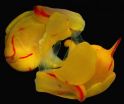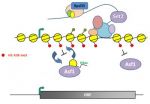(Press-News.org) A new class of organic materials developed at Northwestern University boasts a very attractive but elusive property: ferroelectricity. The crystalline materials also have a great memory, which could be very useful in computer and cellphone memory applications, including cloud computing.
A team of organic chemists discovered they could create very long crystals with desirable properties using just two small organic molecules that are extremely attracted to each other. The attraction between the two molecules causes them to self assemble into an ordered network -- order that is needed for a material to be ferroelectric.
The starting compounds are simple and inexpensive, making the lightweight materials scalable and very promising for technology applications. In contrast, conventional ferroelectric materials -- special varieties of polymers and ceramics -- are complex and expensive to produce. The Northwestern materials can be made quickly and are very versatile.
In addition to computer memory, the discovery of the Northwestern materials could potentially improve sensing devices, solar energy systems and nanoelectronics. The study will be published Aug. 23 by the journal Nature.
"This work will serve as a guide for designing these materials and using ferroelectricity in new ways," said Samuel I. Stupp, Board of Trustees Professor of Chemistry, Materials Science and Engineering, and Medicine. He is a senior author of the paper. "Our molecular design enables us to invent a nearly infinite library of ferroelectric materials."
Ferroelectric materials exhibit spontaneous electric polarization (making one side of the material positive and the opposite side negative) that can be reversed by the application of an electric field (from a battery, for example). These two possible orientations make the materials attractive to researchers developing computer memory because one orientation could correspond to a 1 and the other to a 0. (Computer memory stores information in 1's and 0's.)
"The material's behavior is complex, but the superstructure is simple," said Sir Fraser Stoddart, Board of Trustees Professor of Chemistry in the Weinberg College of Arts and Sciences at Northwestern. He also is a senior author. "It is the superstructure that gives the material its desirable properties."
The two first authors of the paper are Alok Tayi, a former graduate student in Stupp's lab and now a postdoctoral fellow at Harvard University, and Alexander Shveyd, a former graduate student in Stoddart's lab and now a postdoctoral fellow at the University of Rochester.
These new supramolecular materials derive their properties from the specific interaction, repeated over and over again between two small alternating organic molecules, not from the molecules themselves. The two complementary molecules interact electronically and so strongly that they come close together and form very long crystals. This highly ordered 3-D network is based on hydrogen bonds.
In particular, the materials could help address the very expensive upkeep of cloud computing. Facebook, Google, Web-based email and other services are stored in the cloud and rely on volatile memory. When the power is turned off, volatile memory forgets the information it's holding. So the power has to be kept on.
The new ferroelectric materials could be developed into non-volatile memory. With this type of memory, if the power is turned off, the information is retained. If the cloud and electronic devices operated on non-volatile memory, $6 billion in electricity costs would be saved in the U.S. annually, the researchers said.
Current non-volatile computer memories are not based on ferroelectrics. But ferroelectric memories promise to consume less power, last longer and capture data faster than conventional non-volatile memories.
As so often happens in science, serendipity played a role in this discovery of super long crystals. Shveyd was trying to make boxlike molecular rings, but this outcome was never observed. Instead, he stumbled upon the interesting crystals.
"This discovery effectively opened up a Pandora's box," Stoddart said. "Alex started working with Alok in Stupp's group, and the two of them took advantage of the interactions between the two building blocks. They optimized the design so they could grow very long crystals with ferroelectric properties."
"The interaction between the molecules is very strong -- almost like a key in a lock," Shveyd said. "They fit very well together. This interaction produces ferroelectricity, which, to our great surprise, happened at room temperature."
This type of interaction between two molecules previously had been found to give rise to ferroelectricity in three other materials but only below liquid nitrogen temperatures. The new materials developed at Northwestern include additional interactions that enable this property to occur for the first time at room temperature and above.
The new material is all about electron exchange between two small molecules. One molecule is the donor of electrons (red), and the other is the acceptor of electrons (blue). The red and blue molecules are arranged in a mixed stack, and one type alternates with the other. Within that network, each molecule partners with a neighbor and exchanges electrons. Then an electric field is applied, prompting the molecules to switch partners, like dancers on a dance floor. This switch of partners produces ferroelectricity.
The research team developed a library of 10 complexes with this architecture. Three are reported in the Nature paper. The crystals are based on complexes between a pyromellitic diimide-acceptor and donors that are derivatives of naphthalene, pyrene and tetrathiafulvalene.
"The simplicity of our system demonstrates how self-assembly can endow materials with novel functions," Tayi said. "We hope our work motivates chemists and engineers to explore ferroelectricity in organic materials."
###The paper is titled "Room Temperature Ferroelectricity in Supramolecular Networks of Charge-Transfer Complexes."
Future memory
Ferroelectric materials could bring down cost of cloud computing and electronic devices
2012-08-23
ELSE PRESS RELEASES FROM THIS DATE:
Traumatic mating may offer fitness benefits for female sea slugs
2012-08-23
Female sea slugs mate more frequently than required to produce offspring, despite the highly traumatic and biologically costly nature of their copulation, as reported Aug. 22 in the open access journal PLOS ONE.
The authors of the study, led by Rolanda Lange of the University of Tuebingen in Germany, investigated the mating behavior of a simultaneously hermaphroditic species of sea slug that mates via an extravagant ritual that involves a syringe-like penile appendage that stabs the partner to inject prostate fluids and sperm.
Surprisingly, the researchers found that ...
Managerial role associated with more automatic decision-making
2012-08-23
Managers and non-managers show distinctly different brain activation patterns when making decisions, according to research published Aug. 22 in the open access journal PLOS ONE.
The authors of the study, led by Svenja Caspers of the Institute of Neuroscience and Medicine, Research Centre Jülich in Germany, used functional MR imaging to track the decision making process for managers and non-managers. Subjects were required to perform equally repetitive decisions, one form of decision making occurring in every-day work life. The authors found that manager and non-managers ...
Many medications for elderly are prescribed inappropriately
2012-08-23
Approximately one in five prescriptions to elderly people is inappropriate, according to a study published Aug. 22 in the open access journal PLOS ONE.
The authors of the study, led by Dedan Opondo of the Academic Medical Center in Amsterdam, conducted a systematic review of English-language studies of medication use in the elderly and found that the median rate of inappropriate prescriptions was 20.5%. Some of the medications with the highest rates of inappropriate use were the antihistamine diphenhydramine, the antidepressant amitriptyline, and the pain reliever propoxyphene.
INFORMATION:
Citation: ...
Parasitic wasps remember better if reward is greater
2012-08-23
Two parasitic wasp species show similar memory consolidation patterns in response to rewards of different quality, providing evidence that the reward value affects the type of memory that is consolidated. The full results are reported Aug. 22 in the open access journal PLOS ONE.
The researchers, led by Marjolein Kruidhof of the Netherlands Institute of Ecology, tested how wasps store scents associated with situations of low reward (egg-laying into a inferior-quality host species that lays single eggs) versus high reward (egg-laying into a superior-quality host species ...
Patients with anorexia judge own body size inaccurately, view others' accurately
2012-08-23
Patients with anorexia have trouble accurately judging their own body size, but not others', according to research published Aug. 22 in the open access journal PLOS ONE.
In the study, led by Dewi Guardia of the University Hospital of Lille in France, 25 patients with anorexia and 25 controls were shown a door-like aperture and asked to judge whether or not it was wide enough for them to pass through, or for another person present in the room to pass through. In previous similar experiments, anorexic patients felt they could not pass through the door even when it was easily ...
Ready. Get set. Repress!
2012-08-23
KANSAS CITY, MO—The first step in gene expression is the exact copying of a segment of DNA by the enzyme known as RNA polymerase II, or pol II, into a mirror image RNA. Scientists recognize that pol II does not transcribe RNA via a smooth glide down the DNA highway but instead encounters an obstacle course of DNA tightly wound around barrier proteins called histones. Those proteins must be shoved aside for pol II to trundle through.
Previous work from the lab of Jerry Workman, Ph.D., an investigator at the Stowers Institute for Medical Research, showed how a protein ...
Potency of statins linked to muscle side effects
2012-08-23
A study from the University of California, San Diego School of Medicine, published August 22 online by PLoS ONE, reports that muscle problems reported by patients taking statins were related to the strength or potency of the given cholesterol-lowering drugs.
Adverse effects such as muscle pain and weakness, reported to the U.S. Food and Drug Administration (FDA) were related to a statin's potency, or the degree by which it typically lowers cholesterol at commonly prescribed doses.
"These findings underscore that stronger statins bear higher risk – and should be used ...
University of East Anglia breakthrough boosts bacterial understanding
2012-08-23
Having healthy gut bacteria could have as much to do with a strategy that insurance companies use to uncover risk as with eating the right foods, according to researchers at the University of East Anglia (UEA).
Findings published today in Ecology Letters show how researchers applied a strategy used by insurance companies to understand how animals and plants recruit beneficial bacteria.
The breakthrough brings scientists closer to understanding the human body's relationship with bacteria, which account for nine cells out of every 10 in our bodies.
The research has ...
Native landscaping in urban areas can help native birds
2012-08-23
AMHERST, Mass. – A recent study of residential landscape types and native bird communities in Phoenix, Ariz., led by a University of Massachusetts Amherst urban ecologist suggests that yards mimicking native vegetation and wildlands offer birds "mini refuges," helping to offset the loss of biodiversity in cities and supporting birds better than traditional grass lawns and non-native plantings.
The study, led by Susannah Lerman with her advisor Paige Warren at UMass Amherst, and Hilary Gan and Eyal Shochat at Arizona State University, is one of the first to use quantitative ...
Wide circle of friends key to mid-life wellbeing for both sexes
2012-08-23
Friends are equally important to men and women, but family matters more for men's wellbeing Online First doi 10.1136/jech-2012-201113
The midlife wellbeing of both men and women seems to depend on having a wide circle of friends whom they see regularly, finds research published online in the Journal of Epidemiology and Community Health.
A network of relatives is also important—but only for men—shows the study of more than 6500 Britons born in 1958.
The authors base their findings on information collected from the participants, all of whom were part of the National ...
LAST 30 PRESS RELEASES:
Plant hormone allows lifelong control of proteins in living animal for first time
Swedish freshwater bacteria give new insights into bacterial evolution
Global measures consistently underestimate food insecurity; one in five who suffer from hunger may go uncounted
Hidden patterns of isolation and segregation found in all American cities
FDA drug trials exclude a widening slice of Americans
Sea reptile’s tooth shows that mosasaurs could live in freshwater
Pure bred: New stem cell medium only has canine components
Largest study of its kind highlights benefits – and risks – of plant-based diets in children
Synergistic effects of single-crystal HfB2 nanorods: Simultaneous enhancement of mechanical properties and ablation resistance
Mysterious X-ray variability of the strongly magnetized neutron star NGC 7793 P13
The key to increasing patients’ advance care medical planning may be automatic patient outreach
Palaeontology: Ancient tooth suggests ocean predator could hunt in rivers
Polar bears may be adapting to survive warmer climates, says study
Canadian wildfire smoke worsened pediatric asthma in US Northeast: UVM study
New UBCO research challenges traditional teen suicide prevention models
Diversity language in US medical research agency grants declined 25% since 2024
Concern over growing use of AI chatbots to stave off loneliness
Biomedical authors often call a reference “recent” — even when it is decades old, analysis shows
The Lancet: New single dose oral treatment for gonorrhoea effectively combats drug-resistant infections, trial finds
Proton therapy shows survival benefit in Phase III trial for patients with head and neck cancers
Blood test reveals prognosis after cardiac arrest
UBCO study finds microdosing can temporarily improve mood, creativity
An ECOG-ACRIN imaging study solves a long-standing gap in metastatic breast cancer research and care: accurately measuring treatment response in patients with bone metastases
Cleveland Clinic presents final results of phase 1 clinical trial of preventive breast cancer vaccine study
Nationally renowned anesthesiology physician-scientist and clinical operations leader David Mintz, MD, PhD, named Chair of the Department of Anesthesiology at the UM School of Medicine
Clean water access improves child health in Mozambique, study shows
Study implicates enzyme in neurodegenerative conditions
Tufts professor named Fellow of the National Academy of Inventors
Tiny new device could enable giant future quantum computers
Tracing a path through photosynthesis to food security
[Press-News.org] Future memoryFerroelectric materials could bring down cost of cloud computing and electronic devices


